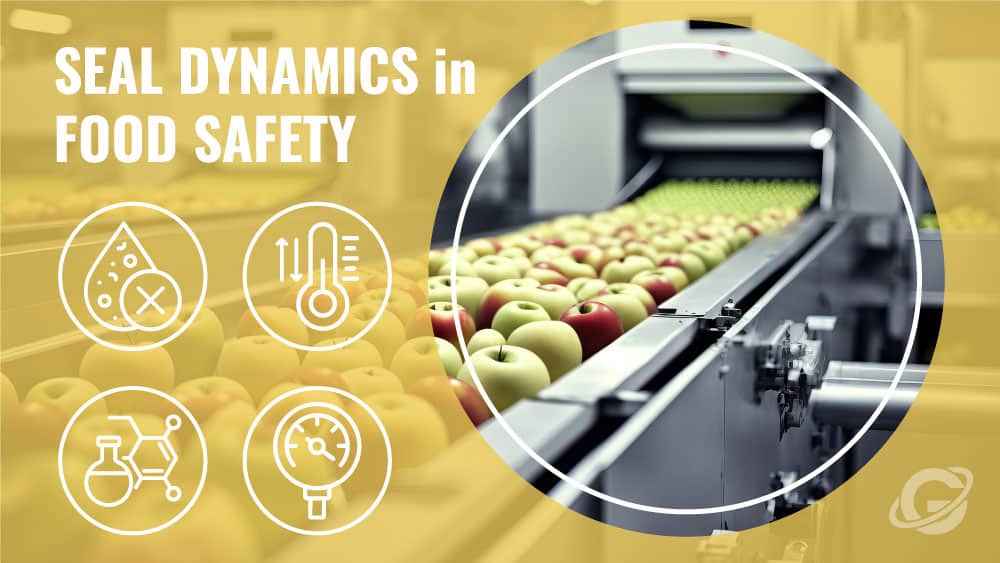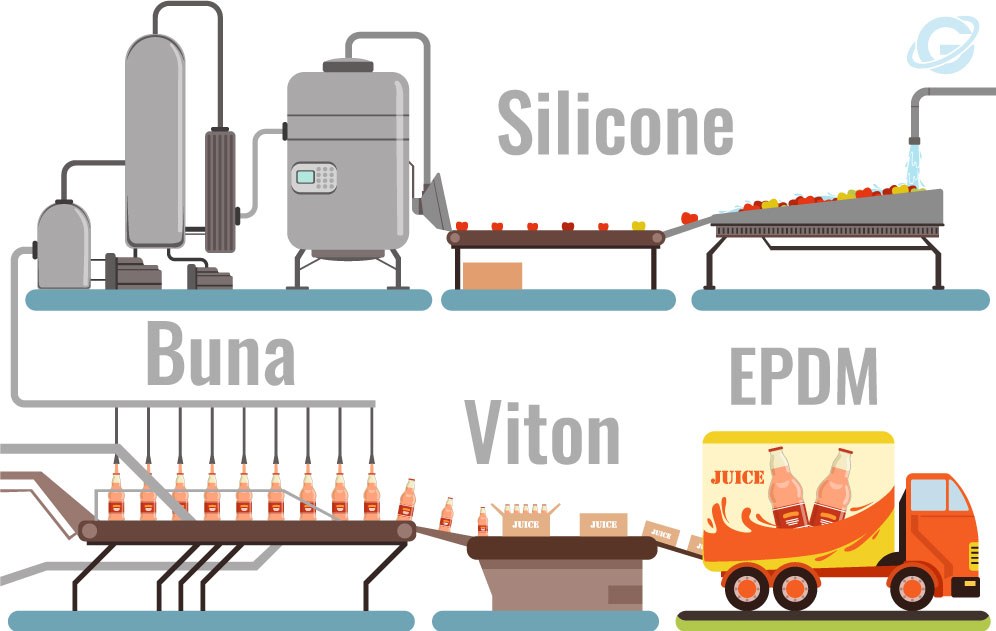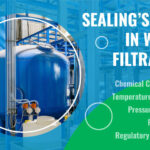
Summary
- Seals in food processing are essential for preventing contamination, maintaining temperature control, meeting pressure and chemical resistance requirements, and ensuring operational safety and efficiency.
- The selection of food-grade seal materials is crucial for safety and compliance, emphasizing non-toxic, inert materials that meet stringent FDA and global standards.
- Effective maintenance and lifecycle management of seals is pivotal for operational efficiency and cost-savings in food processing, emphasizing proactive care and strategic replacement.
Introduction
The fast-evolving world of food processing often underestimates the role of seals, yet it is fundamentally crucial. Seals are not just simple components; they are essential in ensuring the entire food processing operation’s safety, integrity, and efficiency. Seals play many roles, such as preventing contamination, controlling temperature fluctuations, and meeting specific pressure and chemical resistance requirements. This blog post explores the intricacies of seals in food processing, their various roles, the importance of selecting a suitable food-grade material, understanding global standards and compliance, and recognizing the impact of consumer awareness and seal transparency.
Role of Seals in Food Processing

In food processing, seals are integral components that perform various critical functions, such as preventing contamination, controlling temperature fluctuations, meeting specific pressures and chemical resistance requirements, and ensuring the efficiency of automated processes. These roles help maintain the safety, integrity, and efficiency of food processing operations.
Protecting against contamination is one of the most vital roles of seals in food processing. Seals form a physical barrier that prevents external contaminants, such as bacteria, dirt, and other particulates, from entering the processing equipment. This barrier is essential in maintaining the hygiene and safety of the food products. Furthermore, seals prevent leaks, which are not only a contamination risk but can also lead to product loss and equipment damage. Ensuring that these seals are high quality, properly installed, and regularly maintained is crucial in preventing contamination and safeguarding the entire food processing operation.
The role of sealing solutions in temperature control is equally important. Maintaining a consistent temperature is essential for product quality and safety in many food processing applications. Seals contribute significantly by ensuring that equipment compartments are adequately insulated and minimizing temperature changes. This temperature control is especially crucial in processes involving heat-sensitive products or those requiring precise temperature conditions for safety, like pasteurization. The selection of seal materials is a critical consideration here, as different materials respond differently to temperature changes, and the ability to withstand the specific temperature range of the processing environment must be a requirement.
Regarding pressure and chemical resistance, seals in food processing equipment face a challenging environment. They must withstand the physical pressures from machinery and the processing of food products while resisting the chemical effects of cleaning agents and food ingredients. This dual requirement demands a careful balance in seal design and material selection. Seals need to be robust enough to handle high-pressure conditions without failure while also being resistant to corrosion and degradation from harsh chemicals. This demand often leads to using specialized materials and innovative design approaches to ensure that seals can maintain their integrity under these demands.
In the realm of automation, the role of seals is integral to the smooth and efficient operation of machinery. Automated food processing systems rely on seals to prevent fluid leaks and air ingress, which can cause machinery malfunctions and production downtime. Advanced sealing technologies are pivotal in enhancing the reliability and efficiency of these automated systems. They reduce maintenance frequency, increase equipment lifespan, and contribute to the overall optimization of the production process.
Finally, understanding the different types of seals used in the industry is vital. O-Rings, for example, are circular sealing rings mainly used for static applications to prevent leakage of liquids and gases. Gaskets are flat seals that provide a barrier between two surfaces, typically used for preventing leakage in flanged connections. Lip seals, on the other hand, are used in dynamic applications and provide sealing around rotating shafts to prevent fluid leaks while allowing motion. Each of these seal types has unique applications and is chosen based on the specific requirements of the food processing equipment and the conditions under which it operates.
Importance of Food-Grade Seal Materials

In the food processing industry, selecting a suitable seal material is a matter of efficiency, safety, and compliance. Environments where direct and indirect contact with food occurs specifically use food-grade seal materials to maintain these factors.
The unique properties that make food-grade seal materials suitable for food processing applications are the defining factors of the seals. These materials must exhibit durability and resilience to withstand harsh processing environments, including exposure to extreme temperatures, food ingredients, and cleaning agents. Crucially, these materials must be non-toxic and inert, ensuring they do not react with food products or release harmful substances.
The significance of choosing seal materials that do not impart taste or odor to food products is a critical aspect of food safety. The neutrality of these materials in terms of taste and smell is essential, as any interaction with the food products can affect their quality and consumer perception. Methods for assessing and verifying this neutrality are integral to ensuring that the seal materials maintain the purity and integrity of the food products.
Seal materials complying with regulatory standards, particularly FDA requirements, is necessary in the food processing industry. These standards are stringent and encompass a range of criteria from material composition to contamination control. Compliance ensures that the materials used are safe for food contact, capable of withstanding the operational conditions of food processing, and do not introduce contaminants. Achieving compliance involves rigorous testing, documentation, and regular audits. This strongest compliance regime is not just about adhering to regulations but is also crucial for maintaining consumer trust and ensuring public health safety.
When comparing common food-grade materials like Buna, Silicone, and Viton®, a complex interplay of physical and chemical properties, the operational environment, and cost-effectiveness dictate the choice. Buna (Nitrile) is highly valued for its excellent resistance to oils and fats, making it an ideal choice for processes involving oily or fatty foods. However, its performance at extremely high temperatures limits its applications. Silicone stands out for its exceptional flexibility and temperature resistance, making it suitable for various applications, from baking to freezing. Its inert nature also makes it less likely to interact with food products. Viton® (FKM) is renowned for its high chemical resistance. It is suitable for environments with aggressive cleaning protocols and exposure to acidic or flavorful food products. However, the cost of Viton can be a limiting factor for some applications. The decision on which material to use involves considering these properties in conjunction with the specific requirements of the food processing application, including the type of food processed, the processing conditions, and the cleaning and sanitization chemicals used.
Global Standards and Compliance in Food-Grade Sealing
In the intricate world of food processing, adherence to global standards and compliance in food-grade sealing is paramount. Complex international regulations and standards govern this sector to ensure safety and quality, which influences international trade, challenges the maintenance of compliance across diverse markets, and emphasizes the critical role of supply chain management in upholding these standards.
Key international regulatory bodies have established comprehensive standards for food-grade seals. These standards are crucial in ensuring the safety and effectiveness of seals used in food processing. A comparison of major global standards reveals a diverse landscape, with prominent guidelines set by organizations like the FDA in the United States and the European Union. These standards continually evolve, adapting to incorporate new technologies and materials in seal manufacturing, ensuring ongoing relevance and efficacy in a rapidly advancing industry.
International trade agreements and relations significantly influence the standards for food-grade seals. The globalization of the food industry has led to the harmonization of standards in different countries, presenting both challenges and opportunities. Manufacturers must navigate these varying requirements, adapting their products to meet diverse international standards. Strategies for adaptation include staying alongside global regulatory changes and engaging in proactive compliance planning. Understanding the varying regulatory landscapes is essential, especially for multinational operations that must adhere to multiple standards. To ensure compliance in such a complex environment, manufacturers must develop robust strategies, including thorough market research and investment in compliance infrastructure.
Supply chain management is crucial in maintaining compliance with food-grade seal standards. Oversight of the supply chain is critical to ensure that all materials meet the required compliance criteria. Effective supplier management involves stringent quality control measures and regulatory audits to ensure that every component of the supply chain upholds the necessary standards. Additionally, the logistics and distribution aspects of the supply chain are vital in maintaining the integrity of food-grade seals, emphasizing the need for meticulous planning and execution in these operations.
Seal Maintenance and Lifecycle Management in Food Processing
The longevity and efficiency of seals in food processing are as crucial as their initial selection and installation. Proper maintenance and lifecycle management of seals ensure uninterrupted operations and significantly contribute to the overall cost-effectiveness and sustainability of the process.
Effective seal maintenance is key to prolonging the life of seals and preventing unforeseen operational disruptions. Regular inspection of seals for wear and tear, appropriate cleaning procedures, and timely interventions for minor issues are essential practices. Implementing a routine maintenance schedule helps identify potential problems before they escalate, ensuring that seals continue to function optimally. Training staff on recognizing early signs of seal degradation can also play a significant role in maintaining the integrity of the seals and the safety of the food processing operations.
Understanding the lifecycle of seals is pivotal in predicting their performance and planning for replacements. Different seal materials and types have varying lifespans, influenced by factors such as the processing environment, the nature of the food products, and the frequency of cleaning and sanitization processes. Conducting a lifecycle analysis of seals helps make informed decisions about when to replace them, avoiding unexpected failures. This analysis can also inform the selection of more durable materials or designs for specific applications, optimizing the balance between cost and performance.
Strategically managing the replacement of seals can lead to significant cost savings and reduced equipment downtime. Establishing a replacement schedule based on the lifecycle analysis and wear patterns helps plan and budget for replacements. Investing in higher-quality seals may have a higher upfront cost but can result in long-term savings by reducing the frequency of replacements and the risk of costly equipment failures. Additionally, staying updated with advancements in seal technology can provide opportunities to upgrade to more efficient and cost-effective options.
Conclusion
The world of seals in food processing uncovers a landscape where precision, safety, and compliance intertwine with consumer perceptions and market trends. Seals, often unnoticed, play a pivotal role in maintaining the quality and safety of food products. Their selection, governed by stringent regulatory standards and evolving consumer preferences, demands continual innovation and adaptation. As the industry moves forward, understanding and communicating the roles and standards of these vital components becomes increasingly critical. Food processors must stay abreast of technological advancements, regulatory changes, and consumer expectations to ensure that their products meet and exceed safety and quality standards. Seals, in their silent efficiency, are vital guardians of trust in the food processing industry, embodying the commitment to excellence essential in the journey from farm to table.

 English
English  Español
Español  Français
Français  Português
Português  Deutsch
Deutsch  Italiano
Italiano  Русский
Русский  中文
中文  日本語
日本語  العربية
العربية  हिन्दी
हिन्दी 



